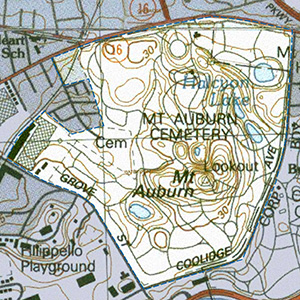Important Bird Area Sites in Massachusetts
Important Bird Area: Mt. Auburn Cemetery
Site Summary
Nominated By
Janet Haywood, Robert Stymeist
Size
175 acres
Towns and Counties
Cambridge, Watertown; Middlesex
Ownership
Mount Auburn Cemetery
Major Habitats
urban/suburban
Land Use
nature/wildlife conservation, tourism, cemetery
Minor Threats
non-native invasive plants, introduced animals and feral pets, cowbird parasitism, water and air pollution
IBA Criteria
- Category 5: Sites important for long-term research and/or monitoring projects that contribute substantially to ornithology, bird conservation, and/or education.
Site Description
Mount Auburn Cemetery is a 175-acre landscaped site of varied topography with four ponds, a renowned horticultural collection, over 20 miles of avenues and paths, and history of over 170 years as the nations first "rural cemetery." Today, Mount Auburn remains an active cemetery dedicated to its original mission of providing burial and commemoration in a site of natural beauty. The present topography creates a series of well-defined spaces. The site is part of a glacial moraine and includes four ponds and a variety of knolls and dells. The highest elevation is a prominent hill, 125 feet above the Charles River now known as Mount Auburn, that provides a panoramic view of downtown Boston and the surrounding countryside. A network of ponds and wetlands and a mature forest of native pines, oaks, and beeches towering over the surrounding farmland created a special rural character in 1831.
Current Conservation Status
Mount Auburn Cemetery is listed on the National Register of Historic Places, 1975, and it has been nominated as a National Historic Landmark. The horticultural collection includes many species and varieties of non-native plants that contribute to diversity and interest of the landscape. However, plants identified as "invasive" are being carefully monitored and removed as appropriate. Yellow iris, for example, once edging the ponds, is being removed and replaced with native species. The large number of Norway Maples, planted in the 1930s and 1940s, are being replaced over time with a greater diversity of tree species. Cats do enter the cemetery from nearby neighborhoods, but there is no feral feline population on the grounds. Cowbirds appear to be relatively few in number. The condition of the water in the ponds is carefully monitored, and the ponds are relatively isolated. Testing of pond water and well water has not indicated any ground water contamination. Studies of the lichen populations indicate that these species reflect a "typical urban lichen pattern". The size and location of the site has meant that there are plant species growing here in relative isolation from other populations. Nearly a dozen mature American Elms still flourish on the site and are being carefully observed. Close inspections are carried out for Hemlock Woolly Adelgid; individual trees are treated with safe oils and soaps as necessary.
Ornithological Significance
Mount Auburn's fame as a spring migrant trap is well earned. Over 170 acres of green nestled in an urban setting beckon coastal migrants to stop to rest and feed, and the numbers and diversity of species can be staggering. Since the beginning of ornithological history in Massachusetts, birders have flocked here to experience this migration, with published records forming a virtually unbroken picture of over a century and a half of spring migration near the coast. While these records are anecdotal at best, it is perhaps the only location in the state where we can track the changes in populations of migrant songbirds.
Some of the more numerous species of warblers observed in spring: Tennessee, Nashville, Yellow, Chestnut-sided, Magnolia, Black-throated Blue, Yellow-rumped, Black-throated Green, Blackburnian, Palm, Bay-breasted, Black-and-white, Canada; American Redstart, Ovenbird, Northern Waterthrush. In addition, Mount Auburn Cemetery is a reliable and nearly annual location for the "semirare" migrants: Gray-cheeked/Bicknell's Thrush, Cape May Warbler, Worm-eating Warbler, Cerulean Warbler, Kentucky Warbler, Mourning Warbler, Hooded Warbler, and Summer Tanager.
Other Flora or Fauna of Significance
There are trees and shrubs that flower through the year, yielding fruits, berries, nuts, seeds, and insects that offer a variety of food to migrant and resident birds and to populations of animals including squirrels, rabbits, woodchucks, skunks, opossum, and raccoons. Foxes and coyotes have been reported. The breeding population of spotted salamanders in the centrally located Dell Pond is thought to be one of the largest colonies in eastern Massachusetts.
Data Sources
Data are based on sightings submitted to Bird Observer based on personal observations from a variety of individuals. The material in the section above was kindly compiled by Marjorie Rines.




